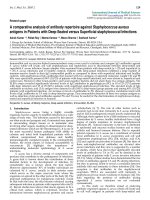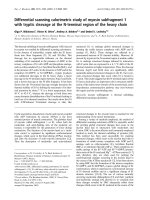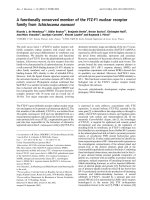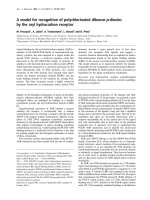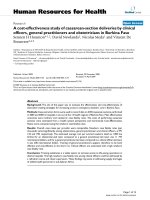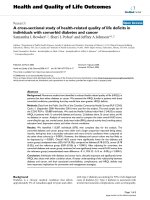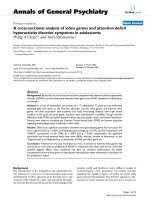Báo cáo y học: "A Comparative Effectiveness Study of Bone Density Changes in Women Over 40 Following Three Bone Health Plans Containing Variations of the Same Novel Plant-sourced Calcium"
Bạn đang xem bản rút gọn của tài liệu. Xem và tải ngay bản đầy đủ của tài liệu tại đây (665.66 KB, 12 trang )
Int. J. Med. Sci. 2011, 8
180
I
I
n
n
t
t
e
e
r
r
n
n
a
a
t
t
i
i
o
o
n
n
a
a
l
l
J
J
o
o
u
u
r
r
n
n
a
a
l
l
o
o
f
f
M
M
e
e
d
d
i
i
c
c
a
a
l
l
S
S
c
c
i
i
e
e
n
n
c
c
e
e
s
s
2011; 8(3):180-191
Research Paper
A Comparative Effectiveness Study of Bone Density Changes in Women Over
40 Following Three Bone Health Plans Containing Variations of the Same
Novel Plant-sourced Calcium
Gilbert R. Kaats
1
, Harry G. Preuss
2
, Harry A. Croft
3
, Samuel C. Keith
1
, and Patti L. Keith
1
1. Integrative Health Technologies, Inc., 4940 Broadway, San Antonio, Texas 78209, USA;
2. Professor of Biochemistry, Physiology, Medicine, & Pathology, Georgetown University Medical Center, Washington D.C.
20057, USA;
3. Croft Research Group, San Antonio, TX, USA.
Corresponding author: Gilbert R. Kaats, Integrative Health Technologies, Inc., 4940 Broadway, San Antonio, Texas, 78209.
Tel: (210)824-4200. Fax: (210) 824-4715 Email:
© Ivyspring International Publisher. This is an open-access article distributed under the terms of the Creative Commons License (
licenses/by-nc-nd/3.0/). Reproduction is permitted for personal, noncommercial use, provided that the article is in whole, unmodified, and properly cited.
Received: 2011.02.02; Accepted: 2011.02.25; Published: 2011.03.02
Abstract
Background: The US Surgeon General’s Report on Bone Health suggests America’s
bone-health is in jeopardy and issued a “call to action” to develop bone-health plans in-
corporating components of (1) improved nutrition, (2) increased health literacy, and (3) in-
creased physical activity.
Objective: To conduct a Comparative Effectiveness Research (CER) study comparing
changes in bone mineral density in healthy women over-40 with above-average compliance
when following one of three bone health Plans incorporating the SG’s three components.
Methods: Using an open-label sequential design, 414 females over 40 years of age were
tested, 176 of whom agreed to participate and follow one of three different bone-health
programs. One Plan contained a bone-health supplement with 1,000 IUs of vitamin D
3
and 750
mg of a plant-sourced form of calcium for one year. The other two Plans contained the same
plant form of calcium, but with differing amounts of vitamin D
3
and other added bone health
ingredients along with components designed to increase physical activity and health literacy.
Each group completed the same baseline and ending DXA bone density scans, 43-chemistry
blood test panels, and 84-item Quality of Life Inventory (QOL). Changes for all subjects were
annualized as percent change in BMD from baseline. Using self-reports of adherence, subjects
were rank-ordered and dichotomized as “compliant” or “partially compliant” based on the
median rating. Comparisons were also made between the treatment groups and two theo-
retical age-adjusted expected groups: a non-intervention group and a group derived from a
review of previously published studies on non-plant sources of calcium.
Results: There were no significant differences in baseline BMD between those who volun-
teered versus those who did not and between those who completed per protocol (PP) and
those who were lost to attrition. Among subjects completing per protocol, there were no
significant differences between the three groups on baseline measurements of BMD, weight,
age, body fat and fat-free mass suggesting that the treatment groups were statistically similar
at baseline. In all three treatment groups subjects with above average compliance had sig-
nificantly greater increases in BMD as compared to the two expected-change reference
groups. The group following the most nutritionally comprehensive Plan outperformed the
other two groups. For all three groups, there were no statistically significant differences
between baseline and ending blood chemistry tests or the QOL self-reports.
Int. J. Med. Sci. 2011, 8
181
Conclusions: The increases in BMD found in all three treatment groups in this CER stand in
marked contrast to previous studies reporting that interventions with calcium and vitamin D
3
reduce age-related losses of BMD, but do not increase BMD. Increased compliance resulted in
increased BMD levels. No adverse effects were found in the blood chemistry tests,
self-reported quality of life and daily tracking reports. The Plans tested suggest a significant
improvement over the traditional calcium and vitamin D
3
standard of care.
Key words: bone mineral density, bone-health supplement, women over-40
Introduction
In the 2010 update to its 2004-2009 Strategic Plan
[1], NIH‟s Office of Dietary Supplements (ODS) en-
courages research assessing the effects of dietary
supplements on biomarkers associated with chronic
diseases, optimal health and improved performance.
One major biomarker of ODS‟s goal was addressed in
the Surgeon General’s Report on Bone Health [2] esti-
mating that by 2020 half of all American citizens over
50 will be at risk of fractures due to poor bone health.
The SG concluded that there is a bone health crisis in
America due to increasingly sedentary lifestyles, ab-
sence of current information about bone health, and
inadequate nutrition. The SG recommended that
people of all ages take steps to improve their bone
density (BMD) by ensuring that they are getting the
recommended amounts of calcium and vitamin D
3
,
and that supplementation may be helpful in meeting
these nutritional goals. Based on findings in the Sur-
geon General’s Report on Bone Health, a “call to action”
was issued for the development of bone health plans
that incorporate three components: (1) increased
physical activity (2) improved health literacy, and (3)
improved nutrition.
In spite of the SG‟s “call to action”, calcium defi-
ciencies remain prevalent throughout the world [3] as
well as in the US [4]. In addition to the persistence of
sedentary lifestyles, poor nutritional habits, and lack
of health literacy, there are other challenges to Amer-
ica‟s bone health that could benefit from supplemen-
tation. The increasing number of the elderly is ex-
tending the progressive age-related decline in BMD,
thereby increasing the need for additional supple-
mental calcium and vitamin D
3
[5]. There are concerns
that current farming techniques are depleting the nu-
tritional composition of vitamins and minerals in our
food supply [6-8]. A wide number of diseases and
medications have been found to have concomitant
adverse effects on bone health [9-13] including the
increasing use of SSRIs for the treatment of depression
[14-17] and contraceptives [18]. Since intentional and
unintentional weight loss typically depletes bone
density [19-30] Americans obsession with dieting will
increase the need for supplementation. This is also
true for the ten-fold increase in the number of bari-
atric surgeries performed in the U.S. to combat the
adverse effects on bone health found associated with
these surgeries [31,32]. In addition to the decline in
bone health associated with sedentary lifestyles, ex-
cessive physical activity observed in athletes, partic-
ularly young athletes, has been shown to have ad-
verse effects on bone health, which could be improved
with supplementation [33-34]. These factors suggest
that the SG‟s 2004 call to action to develop safe and
effective bone health plans is as relevant today as it
was six years ago, and there is an extensive body of
evidence suggesting supplementation with calcium
and vitamin D
3
could help reverse what the SG con-
cludes is a crisis in bone health.
Much of the evidence supporting the value of
calcium supplementation is summarized in an ex-
haustive meta-analysis [5] of randomized trials in-
volving 63,897 subjects 50 years of age and older, most
of whom were healthy postmenopausal women with
an average age of 67.8 years. The meta-analysis in-
cludes 23 trials of 41,419 subjects in which changes in
BMD were the outcome measure, or one of the out-
come measures. No studies reported that supple-
mentation worsened age-related declines in BMD.
Nor were there any studies suggesting that supple-
mentation increased BMD over the study period. The
overall finding was that with or without vitamin D
3
,
calcium supplementation was associated with a “re-
duced rate of bone loss”.
In view of these findings, studying another “me
too” or “more of the same” product that also simply
slows BMD loss would not help to solve the bone
health crisis. What seemed more promising was a
bone health plan with potential to halt, or even re-
verse, age-related BMD loss- a goal made possible
with the Comparative Effective Research (CER) mod-
el. As The American College of Physicians defines it,
CER studies evaluate the relative clinical effective-
ness, safety, and cost of two or more medical services,
drugs, devices, therapies, or procedures used to treat
the same condition [35]. Without demonstrating the
superiority over the existing standard of care and
Int. J. Med. Sci. 2011, 8
182
competing interventions, the acceptability of an in-
tervention becomes heavily dependent upon a com-
pany‟s marketing capability, as opposed to product
superiority proven with safety and efficacy test results
[36]. The emphasis of CER studies is to demonstrate
the superiority of existing products and standards of
care [37]. These types of studies span available inter-
ventions from pharmaceutical treatment, to lifestyle
modifications such as diet, physical activity, and
complementary and alternative therapies that are of-
ten initiated without physician input. But CER studies
face publication challenges that need a paradigm shift
in the scientific community to gain acceptance when
competing against studies using placebo or control
group protocols [38-41].
The purpose of this research was to conduct a
CER study comparing changes in baseline BMD in
healthy women over 40 years of age who followed
one of the three different bone health Plans shown in
Table 1.
Comparisons were also made with two refer-
ences groups of the same age and gender that were
used to calculate expected changes, one without any
form of intervention, and the other using changes
reported in studies using a variety of non-plant
sources of calcium.
Table 1. Components/ingredients in the three bone-health plans
Materials and Methods
The protocol for Plans 2 and 3 were approved by
the RCRC Institutional Review Board
(www.RCRCIRB.com), Austin, TX, Protocol number
1252006. The protocol for Plan 1 was approved by the
researcher‟s ethics committee. Considerable effort was
expended to recruit and enroll subjects using the same
enrollment procedures in order to facilitate be-
tween-group comparisons on relevant outcome
measures.
Due to budget restrictions, instead of simulta-
neously enrolling a control group, the study sponsor
chose to compare the three treatment groups effects
with a pre-existing annualized expected change in
BMD for women over 40 years of age, derived from
data showing that after midlife there is an age-related
yearly loss in both sexes of 1% [42] and an accelerated
loss of up to 2% for 14 years for women of menopau-
sal age [43]. Additional data were obtained from
norms provided by the DXA equipment manufacturer
(GE Lunar), the researcher‟s database of over 26,000
total body measurements, and from the National Os-
teoporosis Foundation [44]. Based on these sources,
we estimated a non-treatment effect of 0.75% per year.
This may be a somewhat conservative estimate in
view of population-based longitudinal studies sug-
gesting that, starting at age 40, there is minor, but
significant, annual bone loss [45] that increases to
0.5% to 0.9% a year in perimenopausal women [46-49],
to above 1% after menopause [48,49] after which the
decline remains about 1% [45,50,51]. Other studies
suggest after midlife there is an age-related yearly loss
of bone in both sexes of 1% [52] which is accelerated to
2% for up to 14 years in women around the age of
menopause [53]. In men, a small loss is detected in
40-year olds [45] that increases to a ~0.8% per year
into old age [45,50-52]. More recently, another review
has suggested that women will lose 35% to 39%, men
17%-19%, of lifetime bone loss after achieving peak
bone mass at ages 30-40 years [54], changes that are
consistent with the previously cited studies.
Another comparison was also made between the
3 active treatment groups with a -0.1% expected an-
nualized changes in BMD when taking vitamin D
3
and non-plant sources of calcium. This calculation
Int. J. Med. Sci. 2011, 8
183
was made from studies cited in Tang et al.‟s [5] ex-
haustive review and additional data provided in
studies [55-59] not cited in Tang et al.‟s review. The
general conclusion from these studies is that supple-
mentation with calcium and vitamin D can slow
age-related declines in BMD, but none of these studies
suggested that supplementation can increase BMD
levels.
Improved nutrition. The bone-health supple-
ments in these plans were analyzed by Exova Labs,
Chicago, IL for confirmation of nutrient levels and
absence of heavy minerals and other contaminating
ingredients. Calcium, magnesium and other minerals
were validated by Advanced Labs, Salt Lake City, UT.
The supplement provided to all study groups
contained a plant-sourced form of calcium with a re-
search identity of DN0361 (commercially known as
„AlgaeCal‟ or „AC‟) made by milling whole,
live-harvested sea algae found on the South American
coastline. In addition to calcium, the algae contained
other naturally occurring minerals in the following
rank-order of percentage: carbon, chloride, magne-
sium, manganese, selenium, silicon, sodium, stron-
tium, titanium and vanadium, boron, silica, and cop-
per. Many of these minerals have been reported to
play a role in bone health. A recent in-vitro study [60]
demonstrated superiority over the two most com-
monly used calcium salts: calcium carbonate and cal-
cium citrate. Cultured human osteoblast cells (hFOB
1.19) were treated with AC, calcium carbonate or cal-
cium citrate. Alkaline phosphatase activity was sig-
nificantly increased with AC treatment when com-
pared to control, calcium carbonate or calcium citrate
(4.0, 2.0 and 2.5-fold, respectively). Proliferating cell
nuclear antigen expression (immunocytochemical
analysis), DNA synthesis (4.0, 3.0 and 4.0 fold, re-
spectively) and Ca2+ deposition (2.0, 1.0 and 4.0 fold,
respectively) were significantly increased in AC
treated cells when compared with control, calcium
carbonate, or calcium citrate treatment. AC treatment
significantly reduced oxidative stress when compared
to calcium carbonate or calcium citrate (1.5, 1.4 fold,
respectively). This earlier study demonstrated that
AC exhibited unique properties compared to calcium
carbonate or calcium citrate on a cellular level, which
suggests the need for human intervention studies
such as the present study. Furthermore, safety and
toxicological investigations were conducted using AC
and demonstrated its broad spectrum safety [61].
Health literacy. To provide a health literacy
component, with permission from the author, subjects
following Plans 1 and 2 were provided with reprints
from Chapters 5, 8, 9 &10 of a published book dealing
with changes in body composition [62]. These chap-
ters provided information on bone density and on the
pedometer-based physical activity program. Calorie
estimation charts and glycemic load tables of over 300
common foods designed to increase the quality of
carbohydrate intakes were also included [62]. Addi-
tional health awareness was gained from the con-
sistent stream of feedback from the pedometer-based
program described below.
Physical Activity. To increase physical activity
levels, subjects were asked to wear a pedometer dur-
ing their waking hours and to record and track their
daily activity levels using the charts and graphs pro-
vided in their health literacy booklet. They were also
asked to follow the instructions for personalizing the
pedometer program to their personal goal weight. The
Digi-Walker pedometer (HealthTech Products, LLC,
San Antonio, TX) used in this study is considered
among the most reliable and valid of pedometers
available [63,64].
Subjects. For all three plans, subjects were con-
tacted using the investigators‟ DXA (Total Body Du-
al-energy X-ray Absorptiometry) database, from par-
ticipants at a local health fair, and from referrals from
subjects who agreed to participate. All subjects certi-
fied that they had reviewed the Informed Consent
with their personal healthcare provider or physician
and that they had no medical conditions that would
preclude their participation. However, pregnant and
lactating women were excluded irrespective of this
certification. Subjects were asked to refrain from tak-
ing other bone-health supplements during the study.
In all three treatment groups, subjects and research
technicians were blinded with regard to the subjects‟
baseline test results. For Plan 1, 60 adults completed a
baseline DXA test, 58 agreed to participate for the
one-year study period and 35 ultimately completed
the study per-protocol (PP). For Plan 2, a total of 274
S‟s were invited to complete a bone density test and to
have the study components explained to them prior to
enrolling for the study. Of these, 158 agreed to par-
ticipate, 125 of whom ultimately completed the study
PP. For Plan 3, 80 adults were invited to complete a
bone density test and to have study components ex-
plained to them prior to enrolling, 58 of whom agreed
to participate and 51 completed the study PP. Figure 1
shows a flow diagram through the study for the three
study groups.
To encourage candid reporting to allow for
dose-related and compliance comparisons, all en-
rolled subjects were paid a “reporting fee” of
$2.00/day for providing daily reports of their sup-
plement usage and side effects. Throughout the study,
subjects were repeatedly reminded that this fee was
not an incentive for taking the product, but rather was
Int. J. Med. Sci. 2011, 8
184
for the purpose of encouraging candid reporting to
allow for analyses of the effects of adherence. Subjects
were also advised that the reporting fees would be
paid irrespective of product usage as long as the par-
ticipant completed all ending tests. This procedure
was also designed to provide an additional measure
of product efficacy on the assumption that if a plan
was efficacious, compliant subjects should outper-
form partially compliant subjects.
Figure 1. Flow of participants through the three study legs
Outcome Measure of efficacy. Although the
primary outcome measure for all three study groups
was changes in BMD among highly compliant sub-
jects when following each of the three plans, data was
also reported for the entire cohort for each Plan. BMD
was assessed by dual-energy X-ray absorptiometry
(DXA) total body scans (GE Lunar, LUNAR Corpora-
tion, Madison, WI, USA). Longitudinal precision of
the DXA unit was monitored using repeated
measures of total bone density phantoms provided by
the manufacturer.
Outcome Measure of safety. To assess safety in
all three Plans at baseline and at the end of the study
period, subjects completed the 50-item Quality of Life
inventory [64] shown in Table 2, the 43-item blood
chemistry panel shown in Table 3, and daily tracking
self-reports on positive/negative reactions to the
product and product usage.
Compliance. In order to obtain a compliance
rating (since poor compliance is a major obstacle to
obtaining the full benefit of bone-health supplements)
[5], the research technician who had the most frequent
contact with S‟s (subjects) rated the subjects‟ compli-
ance with the protocol using a 5-point scale. Each
group was then rank-ordered and dichotomized at the
median. When making these ratings and classifica-
tions, both the technician and the investigator were
blinded with respect to the subject‟s BMD measure-
ments. Those above the median were classified as
“compliant”, and those below the median were clas-
sified as “partially compliant.”
Statistical Methods
Since the study period for Plan 1 was one year
and the study period was six-months for Plans 2 and
3, BMD changes and comparisons were reported as
mean annualized percent change (MPAC). Annual-
izing changes also allowed easier comparisons with
other studies reported in the literature.. Continuously
distributed data were summarized with the mean and
standard deviation; binary outcomes were summa-
rized with counts and percents. Study groups were
contrasted on MAPC (Mean Annualized Percent
Change in BMD) with analyses of covariance with
adjustment for age and sex. Group contrasts with re-
gard to binary outcomes were made with Pearson‟s
chi-square. All statistical testing was 2-sided with a
significance level of 5%. SAS Version 9.1.3 for Win-
dows (SAS Institute, Cary, North Carolina) was used
throughout.


